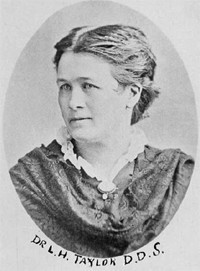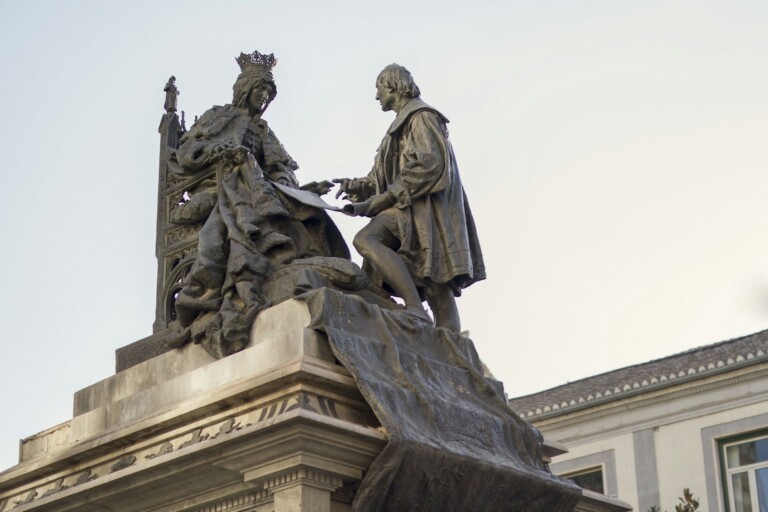A. The Queen Isabella Association.
What does it have to do with dentistry? Good question.
On researching the history of Lucy Hobbs Taylor, the first woman in American to graduate with a dental degree, I found out she belonged to this remarkable group. In fact, the story of how she became a dentist (written by her, in the third person), was commissioned by Mary Gage Day, M. D., the Chairman of the Kansas branch of the medical department of the Queen Isabella Association. After some more research, I found out that while Dr. Day was the Chairman of the Kansas branch; Lucy Hobbs Taylor was the Vice Chairman of the same branch as of 1892. Then I wondered, what is this group and why would such forward-thinking ladies be a part of it?

Though a statue of Queen Isabella, the ‘codiscoverer of the New World’ was not erected at the Columbian Exposition in 1893, this monument in Andalusia, Spain accurately depicts her support for the explorations of Christopher Columbus.
The Queen Isabella Association was incorporated in Chicago in 1889. Their original short-term goal was to erect a statue of Queen Isabella, acknowledging her as the ‘codiscoverer of the New World’ and to build a pavilion dedicated to and for women at the upcoming World’s Columbian Exposition of 1893 in Chicago (shown above). The Exposition was to commemorate the founding of the New World by Columbus. The group was different than other ladies’ organizations of the day, which focused exclusively on philanthropy and charitable works. This group’s purpose was to advance the cause of women’s suffrage and equal rights. While they were originally incorporated in Chicago, they eventually had chapters all over the country, like the one Dr. Hobbs Taylor was Vice Chairman of. They saw themselves as more than a group organized for a one-time event, but as a support network for women who were pursuing a professional career. This was unique at a time when most women’s groups were created

Dr. Lucy Hobbs Taylor served as Vice Chairman of the Kansas branch of the Medical Department of the Queen Isabella Association in 1892.
for the purpose of philanthropic works or for pleasure. They did not believe that their roles as women were limited to being daughters, wives and mothers, which was radical for the time.
In their work for the Chicago Exposition, the Isabellas, as they were informally known, went up against the more traditional Chicago Women’s Auxiliary, which was established later in 1889. The Auxiliary had three goals: to erect a Woman’s Building, a discussion of charity and philanthropic work, and to help Chicago’s businessmen sell shares in the Chicago Fair corporation. The women on the Auxiliary were the wives of prominent and wealthy husbands. The two groups had very different ideas about women’s roles and were bound to clash. Both groups wanted to build a building dedicated to Woman, but for different reasons. There was to be a Board of Lady Managers who would work with the two established male-only boards designing and overseeing all projects and buildings related to the Exposition. Ladies from both the Isabellas and the Women’s Auxiliary wanted to be on this main board and have a hand in influencing this ground-breaking Exhibition. The Women’s Auxiliary was made up of traditional-minded, wealthy women, whose husbands were well-connected Chicago businessmen. The Isabella Association was mostly made up of middle-class, professional women, looking to establish a new idea of what women’s work was. The women who won a greater number of seats on the board would control it. The ladies of the Isabellas had a national agenda, while the ladies of the Auxiliary were made of up local, Chicago women and had a local ties to Chicago and were very influential.
Sadly, the way the seats were chosen favored the stereotypically traditional women of the Auxiliary and so the aim of these women was to play second fiddle to the men, support them, and advocate and celebrate traditional gender roles for women.
The Women’s Building that was finally constructed, showcased women’s work as second to men and of inferior in value and significance, which differed from the aim that the Isabellas had for their Women’s Building, which was to showcase women’s achievements on par with men.
Since then, the world has more readily acknowledged the view of women that trailblazing people like Dr. Lucy Hobbs Taylor and her Queen Isabella Association represented.

Jenn Ochman, second from left, portrays Dr. Lucy Hobbs, the first female to earn a dental degree in the U.S. during a 2016 event celebrating Women’s History Month at Marywood University in Scranton, Pennsylvania. The Lucy Hobbs Project, powered by Benco Dental, supports women in dentistry nationwide.


